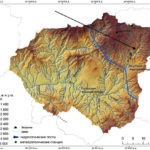UDC 551.573:551.579.5(470)
Titkova T.B., Zolotokrylin A.N., Cherenkova E.A. MODERN CLIMATE TRENDS OF CHANGES IN EVAPORATION AND SOIL MOISTURE IN THE SOUTH OF EUROPEAN RUSSIA // Arid Ecosystems. 2023. Vol. 29. № 3 (96). P. 4-14. | PDF
We studied an impact that climate parameters had on evaporation during the active growing season of plant in forest steppe, steppe and semiarid areas in 1980-2021, in the south of European Russia. We analyzed the main patterns of the connection between evaporation and soil moisture. At the beginning of the growing season, a change in evaporation in forest and steppe was largely determined by the positive connection with temperature and wind. In the middle of the season, the role of precipitation and wind increased even more. Starting in July, the connection between evaporation and air temperature turned negative due to the water shortages in dry subhumid and semiarid climates. At the beginning, the connection between evaporation and surface moisture was negative, and the surface evaporation was minimal since the soil cover was not yet warm enough in steppe and forest steppe zones. However, this connection was positive in warm soil in the semidesert. Starting from the middle of the season and until its end, the connection between evaporation and soil moisture was significantly positive everywhere from forest steppe to semiarid zones. At the beginning, the continuous warming increased the evaporation. In the middle and the end, evaporation trends were significantly negative because the insufficient moisture at higher temperatures resulted in drying of the soil cover and early vegetation decay. The largest evaporation decline was noted in steppe and dry steppe landscapes, caused by the overall drying of the territory when the air temperatures grew, as well as by the decrease both of precipitation and the average wind speed. Surface moisture trends were mostly negative in the south of European Russia, with the maximum moisture loss in broadleaf forests and forest steppe because they were more humid compared to dry steppe and semiarid zones. Changes in soil moisture in the semiarid zone throughout the entire warm period were minimal.
Keywords: evaporation, air temperature, precipitation, wind, soil moisture, natural zones, growing season.
Financing. The study of the influence of climatic parameters on evaporation was carried out within the framework of scientific topic No. 0127-2019-0010 (AAAA19-119102890091-1) “Development of Scientific Foundations for Sustainable Management of Natural and Anthropogenic Systems Based on Balanced Land Use Models”; the analysis of trends in abnormal regimes of soil moisture was financially supported by the Russian Science Foundation, project No. 19-17-00242.
DOI: 10.24412/1993-3916-2023-3-4-14
EDN: ZUWGEV







